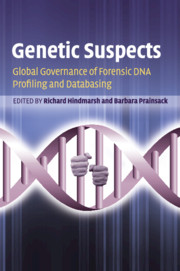Book contents
- Frontmatter
- Contents
- List of contributors
- About the contributors
- Foreword
- Acknowledgements
- 1 Introducing Genetic Suspects
- Section 1 Key areas in DNA profiling and databasing
- Section 2 National contexts of forensic DNA technologies and key issues
- 7 DNA databases and the forensic imaginary
- 8 Partners in crime: the use of forensic DNA technologies in Austria
- 9 Inquisitorial forensic DNA profiling in the Netherlands and the expansion of the forensic genetic body
- 10 DNA the Nor-way: black-boxing the evidence and monopolising the key
- 11 Portuguese forensic DNA database: political enthusiasm, public trust and probable issues in future practice
- 12 On trial! Governing forensic DNA technologies in the USA
- 13 Biosurveillance and biocivic concerns, from ‘truth’ to ‘trust’: the Australian forensic DNA terrain
- 14 Finding the balance: forensic DNA profiling in New Zealand
- 15 Forensic DNA profiling and databasing: the Philippine experience
- Section 3 Conclusions
- Index
- References
9 - Inquisitorial forensic DNA profiling in the Netherlands and the expansion of the forensic genetic body
from Section 2 - National contexts of forensic DNA technologies and key issues
Published online by Cambridge University Press: 05 October 2012
- Frontmatter
- Contents
- List of contributors
- About the contributors
- Foreword
- Acknowledgements
- 1 Introducing Genetic Suspects
- Section 1 Key areas in DNA profiling and databasing
- Section 2 National contexts of forensic DNA technologies and key issues
- 7 DNA databases and the forensic imaginary
- 8 Partners in crime: the use of forensic DNA technologies in Austria
- 9 Inquisitorial forensic DNA profiling in the Netherlands and the expansion of the forensic genetic body
- 10 DNA the Nor-way: black-boxing the evidence and monopolising the key
- 11 Portuguese forensic DNA database: political enthusiasm, public trust and probable issues in future practice
- 12 On trial! Governing forensic DNA technologies in the USA
- 13 Biosurveillance and biocivic concerns, from ‘truth’ to ‘trust’: the Australian forensic DNA terrain
- 14 Finding the balance: forensic DNA profiling in New Zealand
- 15 Forensic DNA profiling and databasing: the Philippine experience
- Section 3 Conclusions
- Index
- References
Summary
INTRODUCTION
During the 1990s in the Netherlands, DNA profiling became established as a mechanism to provide legal evidence for severe, violent crimes, including sexual assault, manslaughter and murder. That development was in accord with what Williams and Johnson (2008: 1) have observed in many jurisdictions regarding the transformation of DNA profiling into an important tool in processes of crime investigation and usage in so-called ‘volume crimes’. Drawing upon the Dutch situation, this chapter first describes how Dutch DNA profiling became governed through legal measures and the inquisitorial orientation of the Dutch legal system. Second, the trajectory – the lines of development – of Dutch DNA profiling practices, is described, outlining who and what has been involved in DNA profiling. This account will provide insight into, first, the strategies employed by various stakeholders to achieve the current situation, where DNA profiling is deployed extensively and routinely in volume crimes, and, second, DNA profiling applied in the process of crime investigations. Hence, the analysis contributes to the understanding of how current DNA profiling practices were realised in a country – the Netherlands – that has what can be referred to as an ‘inquisitorial legal orientation’, where judges function as impartial fact finders. Finally, some implications for current directions in the governance of Dutch forensic DNA profiling practices are outlined.
- Type
- Chapter
- Information
- Genetic SuspectsGlobal Governance of Forensic DNA Profiling and Databasing, pp. 175 - 196Publisher: Cambridge University PressPrint publication year: 2010
References
- 6
- Cited by



